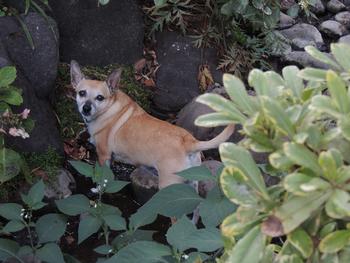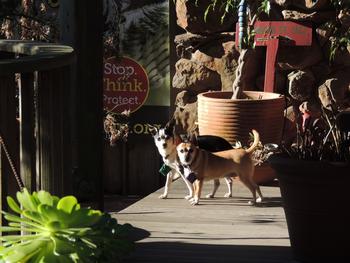Dogs in the garden
-
Diane Lynch
-
Throughout my adult life, I’ve had a dozen dogs who brought my family much joy. I like dogs better than some people, though there have been moments when I wasn’t happy with a few of them.
 The plant at her feet is in the nightshade family, and some are toxic though my gardener says they eat this one in Central America. Photo: Diane Lynch
The plant at her feet is in the nightshade family, and some are toxic though my gardener says they eat this one in Central America. Photo: Diane LynchI figured out not to use blood meal in the garden since dogs are certain you’ve planted a steak for them to dig up. Alice, a cocker-PBGV mix, was inadvertently closed into the garage and chewed through a large bag of blood meal, earning her a trip to the vet. Bone meal can have a similar attraction for dogs. You may need to consider other products, such as seaweed-derived liquids.
Milly, Alice’s mother, developed a taste for asparagus at our farm. This got my attention right away, and the fix was simple: close the garden gate.
Peggy, our current dog, buries her green treats, then digs them up and re-buries them over and over…OCD? Because she’s a little chihuahua mix, she doesn’t do much damage. A larger dog can endanger your valued plants, so maybe he only gets such treats indoors. Why do dogs dig anyway? For many reasons: to stay warm or cool, create a den after a ground dweller below.
Big dogs can present bigger problems. If your dog has created trails through the garden, it may be easiest to allow his natural flow and enhance the pathways with small mulch (avoid cocoa bean mulch), pea gravel, bricks, or stepping stones—some habits are difficult to change. And remember, he’s patrolling to keep you safe. If said big dog likes to nap on your hellebores or ferns, consider strategically placing large rocks to make this bed less appealing. Or maybe you put in some attractive fences to cordon off some of the valued plants. Consider putting a mesh bed with legs out somewhere shady for him or even a couple of small patches of lawn (or artificial turf) in his favorite spots. Sniffing is what dogs do best. Because they’re small, there has been little damage, but large dogs can be challenging. Photo: Diane Lynch
Sniffing is what dogs do best. Because they’re small, there has been little damage, but large dogs can be challenging. Photo: Diane LynchThink about what products you’re using in the garden. Some may not be necessary. Pest control products should be used carefully and with an effort to minimize anything toxic to you or your dog. Integrated pest management (IPM) principals stress using the least toxic product first and anything stronger if absolutely necessary to control a pest. Keep dogs inside when spraying or applying products until dry.
If you have a dog, often a puppy, that insists on eating plants, you may want to consider not planting known toxic plants such as azaleas and rhododendrons, yew, cyclamen, daffodils, hyacinths and tulips, oleander, lilies, tomatoes, grapes, sago palm and autumn crocus (Colchicum autumnale), along with common houseplants dieffenbachia and kalanchoe.
If you have an area of the garden that’s a favorite toilet spot and it’s smelly in warm weather, you could consider planting some herbs and other fragrant plants. Catmint, lavender, sage, rosemary, lemon balm, thyme, marjoram, oregano, and mint come to mind. Vines such as honeysuckle and some clematis can add wonderful fragrance, but be aware that maintenance will be needed to keep some vines from taking over…
Most dogs want to please us, so training a dog to stay out of certain areas is possible and in his best interest so you’ll be happy with him. Remember to reward good behavior. Eventually, you can have what you want: a nice garden and an enjoyable outdoor area for your doggy.
I’m not especially into poetry, but Billy Collins has written about dogs and cats a lot, and my two favorite poems on dogs are Dharma and The Revenant—look them up online for some chuckles. Enjoy your dog and your garden this summer whenever it decides to arrive.
Pet Poison Helpline is a for-profit resource that may be helpful: www.petpoisonhelpline.com, 800-213-6680, or petpoisonhelpline.com. Also, visit aspca.org/toxicplants for information.


